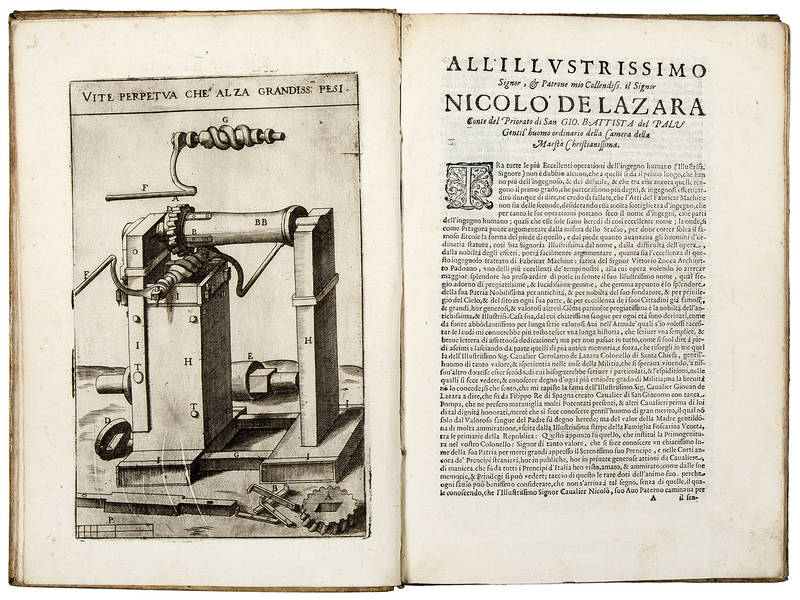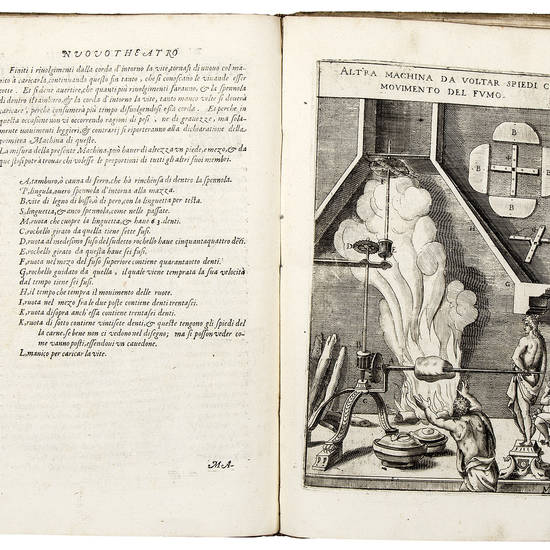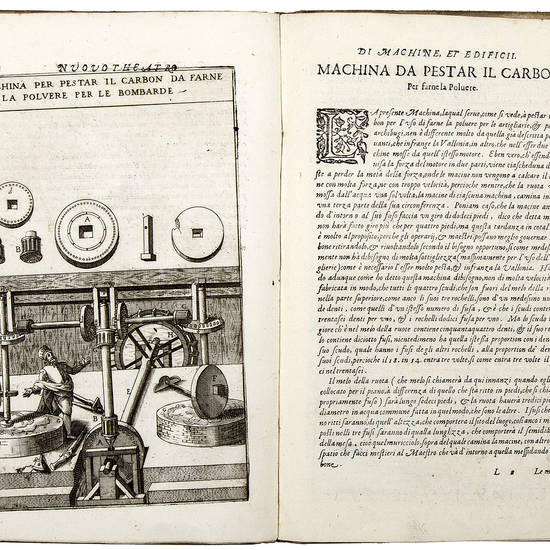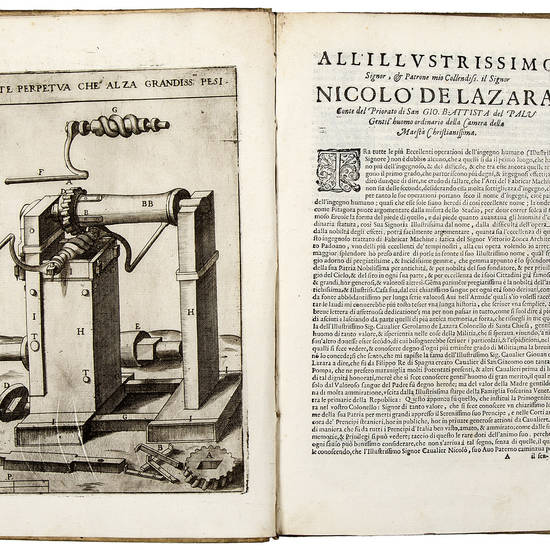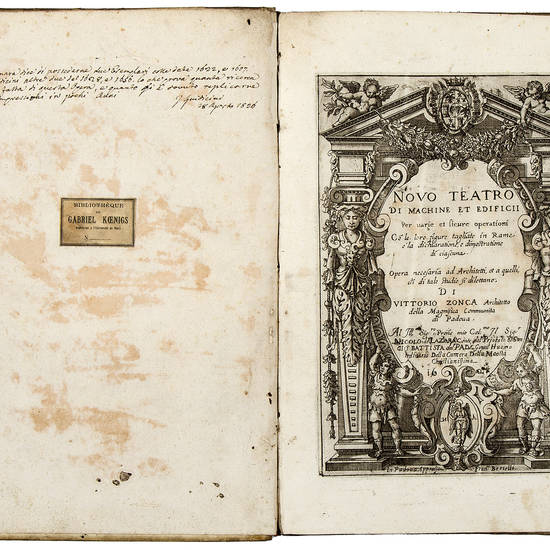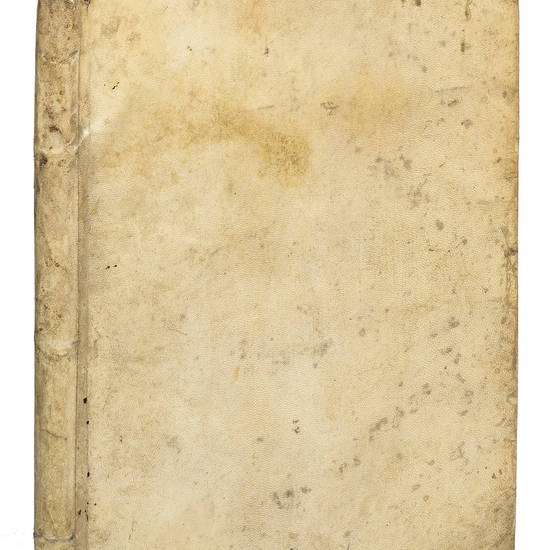THE COPY OF THE ITALIAN ENGINEER GIUSEPPE GUIDICINI AND THE FRENCH MATHEMATICIAN GABRIEL KOENIGS
Folio (300x206 mm). [8], 115, [1] pp. and [2] leaves, inserted between pp. 88-89, bearing 3 engravings signed “Ben. W. fe.” for Benjamin Wright. Collation: [p]2 A2 2A4 B-O4 P2. Engraved architectural title page and 42 full-page engravings in the text. Woodcut initials. Contemporary flexible vellum (spine slightly worn, some staining on the panels). On the front flyleaf verso printed bookplate “Bibliothèque de Gabriel Koenigs Professeur à l'Université de Paris”, above which is a bibliographic manuscript note signed “Guidicini, 28 agosto 1826” (see below). Some marginal staining, small vertical tear to the lower margin of l. B1 not affecting the text, some plates with pale impression, all in all a very good, wide-margined copy.
Second Edition (a reimpression of the first of 1607, also by Bertelli, except for a new dedication by the publisher to Nicolò de Lazara) of one of the great classics among the machine books produced in the late Italian Renaissance. Along with Branca, Ramelli, Veranzio, Biringuccio, and Cardano, Zonca represents one of the leading exponents of what A.P. Usher (A History of Mechanical Inventions, New York, 1929) called the “school of Italian engineers”, all of whom are in some way indebted, directly or indirectly, to Leonardo's work. With them Zonca's book shares the superb quality and conspicuous quantity of figures, the practical purpose of informing craftsmen and engineers about the latest technological developments, the search for new sources of energy and, last but not least, the philanthropic desire to lighten and simplify human labor.
All the machines are illustrated and described in detail. Of particular interest are those used in the manufacturing of silk and other textiles and those used for printing. The work also includes the first known depiction of a “follone”, that is, the machine used for fulling felts and other fabrics, which was sometimes used as a sort of an ante litteram village washing machine (see U. Forti, Storia della tecnica dal Medioevo al Rinascimento, Florence, 1957, pp. 154-155).
According to D. Hunter (Papermaking through eighteen centuries, New York, 1930, p. 167) the figure on p. 94 (Cartiera overo pistogio che pesta le strazze per far la carta) is the “the first illustration of a stamping mill”.
Of culinary interest is the plate entitled “Machina da voltar spiedi per cuocer vivande”, which shows a mechanical roasting spit (cfr. Arte della cucina e alimentazione nelle opere a stampa della Biblioteca Nazionale Marciana dal XV al XIX secolo, Rome, 1987, p. 285, no. 1714).
Some figures bear the monogram FV, which stands for Francesco Valesio, others the monogram Ben W sc for Benjamin Wright, others an unidentified AH or AHI or AI (see G.K. Nagler, Die Monogrammisten, II, no. 2535 and I, no. 1792).
Vittorio Zonca was an Italian inventor and engineer. In 1597 he was appointed architect of the city of Padua, a honorary position which, however, apparently did not allow him to practice his profession. The Novo teatro was published posthumously in 1607. The work enjoyed great fortune, and was reprinted four times in the first half of the 17th century. The publisher, Pietro Bertelli, was active in those years in the Venetians as both printer and engraver (see Bénézit, I 689).
Riccardi, I 667; Italian Union Catalogue, IT\ICCU\LO1E\008019; Cicognara, 970; Dibner 173; Usher, Mechanical Inventions, 232; Libri, Sciences Mathématiques en Italie, IV, 58-59.
Provenance.
The ownership note on the front flyleaf “Guidicini, August 28, 1826” seems to be ascribable to the Bolognese engineer Giuseppe Guidicini. “Some elements seem to lead in this direction. First, the chronology seems to coincide: Giuseppe was born on August 29, 1763, and died on January 25, 1837. In the year 1826, the date reported in the manuscript note, the Bolognese was alive and aged 63 years. Another detail that makes this association plausible is the fact that in 1791 Giuseppe became a public engineer and architect and that throughout his life he devoted himself to collecting and studying books and documents pertaining mainly to town planning. It is therefore not difficult to think that such a figure could have been interested in a work like Vittorio Zonca's Novo Teatro. But the element that most of all seems to tie the figure of Giuseppe to the present book is the calligraphy and even more so the handwritten signature. Looking for other documents owned with certainty by G. Guidicini, one can come across a manuscript dated 1818 and kept at the Biblioteca dell'Archiginnasio in Bologna, containing 4 leaves and 156 plates. Some of these bear handwritten notes by Guidicini on the verso. The type of information reported and especially the handwriting are very similar to the autograph note found in the present copy of the Novo Teatro. If one analyzes the signature, one can also state, almost with certainty, that this is the same as that found on another document, also at the Biblioteca dell'Archiginnasio in Bologna, bearing a recognized signature of Giuseppe Guidicini. Considering all these elements, there is therefore a possible overlap between the Guidicini owner of the present volume and Giuseppe Guidicini the scholar and the engineer.
On the same page as Guidicini handwritten dedication there is another ownership entry: a printed ex-libris of the ‘Bibliothèque de Gabriel Koenigs Professeur à l'Université de Paris', that is, the library of Gabriel Koenigs, a French mathematician who was born on January 17, 1858, in Toulouse, France, and died on October 29, 1931, in Paris. He begun studying at the University of Paris in 1882 as agrégé répétiteur, but it was probably in 1886, when he was appointed professor of mathematics at the École Normale and deputy director at the Sorbonne, that he gave birth to the library mentioned above. Not much is known about Koenigs as a bibliophile, as references to his library are very few; what is known, however, is that he developed a method of teaching mechanics based on theoretical physics, experimental research and industrial applications. This may bring us to think that Zonca's book was not only physically present in Koenigs's library, but that perhaps he used it for his studies and for his teaching. If so, even some three hundred years after the date of its composition, the Novo Teatro did not lose its usefulness and modernity” (E. De Francesco, Stampe postillate nel catalogo della Libreria Alberto Govi, Dissertation Theses, University of Verona, 2019-2020, pp. 15-17).
[7302]

